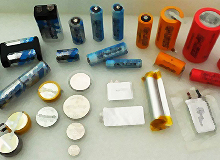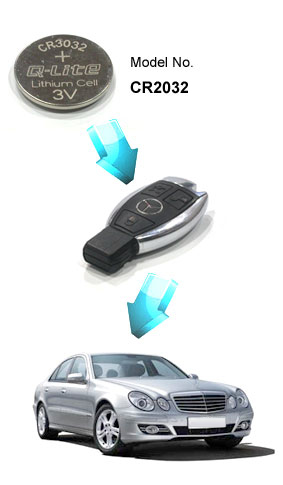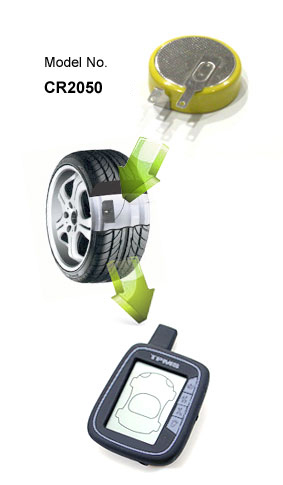![]() Lithium Primary Battery
Lithium Primary Battery
Lithium-Manganese Dioxide Cells

| Model No. | Nominal Volt | Nominal Capacity | Standard Discharge | Max Discharge Current (mA) | Dimensions Max (mm) | Wt | |
| V | mAh | mA | Continuous | Pulse | Dia x H | g | |
| CR927 | 3 | 30 | 0.1 | 0.2 | 5 | 9.5 × 2.7 | 0.6 |
| CR1025 | 3 | 30 | 0.1 | 0.2 | 5 | 10.0 × 2.5 | 0.7 |
| CR1216 | 3 | 25 | 0.1 | 0.2 | 5 | 12.5 × 1.6 | 0.7 |
| CR1220 | 3 | 38 | 0.1 | 0.2 | 5 | 12.5 × 2.0 | 0.8 |
| CR1225 | 3 | 50 | 0.1 | 0.2 | 5 | 12.5 × 2.5 | 0.9 |
| CR1616 | 3 | 50 | 0.1 | 0.3 | 8 | 16.0 × 1.6 | 1.2 |
| CR1620 | 3 | 70 | 0.1 | 0.3 | 8 | 16.0 × 2.0 | 1.3 |
| CR1625 | 3 | 90 | 0.1 | 0.3 | 8 | 16.0 × 2.5 | 1.8 |
| CR1632 | 3 | 120 | 0.1 | 0.3 | 8 | 16.0 × 3.2 | 2 |
| CR2016 | 3 | 75 | 0.2 | 0.5 | 10 | 20.0 × 1.6 | 2 |
| CR2025 | 3 | 150 | 0.2 | 0.5 | 10 | 20.0 × 2.5 | 2.6 |
| CR2032 | 3 | 210 | 0.2 | 0.5 | 10 | 20.0 × 3.2 | 3.2 |
| CR2320 | 3 | 130 | 0.2 | 0.75 | 15 | 23.0 × 2.0 | 3 |
| CR2325 | 3 | 190 | 0.2 | 0.75 | 15 | 23.0 × 2.5 | 3.3 |
| CR2330 | 3 | 260 | 0.2 | 0.75 | 15 | 23.0 × 3.0 | 4 |
| CR2335 | 3 | 300 | 0.2 | 0.75 | 15 | 23.0 × 3.5 | 4.3 |
| CR2354 | 3 | 530 | 0.2 | 0.75 | 15 | 23.0 × 5.4 | 6 |
| CR2430 | 3 | 270 | 0.3 | 10 | 15 | 24.5 × 3.0 | 4.5 |
| CR2450 | 3 | 600 | 0.3 | 10 | 15 | 24.5 × 5.0 | 6.6 |
| CR2477 | 3 | 1000 | 0.3 | 10 | 15 | 24.5 × 7.7 | 10.5 |
| CR3032 | 3 | 500 | 0.3 | 10 | 20 | 30.0 × 3.2 | 6.8 |
High Drain Type models are derived from the Standard Type in order to meet with market demand growing
for pulse discharge and cycle use more than conventional backup applications.
Q-Lite High Drain Type batteries are capable of delivering excellent pulse discharge performance
with optimized life cycles, which are becoming more and more dominating the market nowadays.
| Model No. | Rated Volt | Rated Capacity | Standard Discharge | Max. Continuous Discharge | Max Pulse | Dimensions Max (mm) | Wt. |
|---|---|---|---|---|---|---|---|
| V | mAh | mA | mA | mA | Dia x H | g | |
| CR1616-PH | 3 | 50 | 0.1 | 2 | 8 | 16.0 x 1.6 | 1.2 |
| CR2016-PH | 3 | 80 | 0.1 | 6 | 20 | 20.0 × 1.6 | 2.0 |
| CR2025-PH | 3 | 160 | 0.2 | 6 | 20 | 20.0 × 2.5 | 2.6 |
| CR2032-PH | 3 | 245 | 0.2 | 6 | 20 | 20.0 × 3.2 | 3.2 |
| CR2354-PH | 3 | 530 | 0.2 | 6 | 30 | 23.0 × 5.4 | 6.0 |
| CR2430-PH | 3 | 285 | 0.2 | 10 | 30 | 24.5 × 3.0 | 4.5 |
| CR2450-PH | 3 | 620 | 0.2 | 6 | 30 | 24.5 × 5.0 | 6.8 |
| CR2477-PH | 3 | 1000 | 0.6 | 6 | 30 | 24.5 × 7.7 | 10.5 |
| CR3032-PH | 3 | 500 | 0.4 | 15 | 40 | 30.0 × 3.2 | 6.8 |
| Note: Rated capacities are for reference only and subject to new confirmation in data sheets updated. | |||||||
CRW cells/batteries refer to Q-Lite new product launch in 2017 in order to cope with robust market demands for high capacity and high power output in lithium Manganese Dioxide technology nowadays.
CRW cell/battery Features:
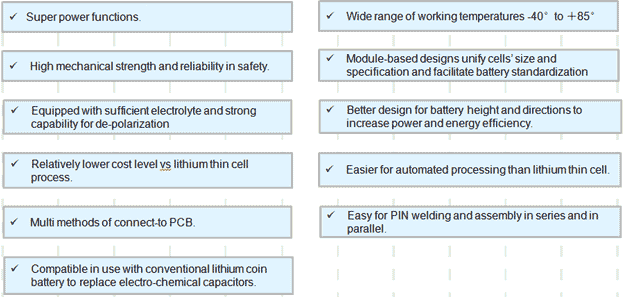
| Model No. | CR24xxW | CR30xxW | CR38xxW | CR42xxW | ||||||||
| CR2430W | CR2450W | CR2477W | CR3032W | CR3050W | CR3077W | CR3832W | CR3850W | CR3877W | CR4232W | CR4250W | CR4277W | |
| Capacity (mAh) |
260 | 468 | 710 | 440 | 792 | 1189 | 730 | 1314 | 1898 | 925 | 1665 | 2405 |
| Max Current (mA) |
22 | 43 | 60 | 45 | 72 | 120 | 76 | 120 | 200 | 97 | 156 | 253 |
| Max Pulse Current (mA) |
60 | 120 | 260 | 120 | 190 | 315 | 207 | 330 | 540 | 260 | 420 | 680 |
| Standard Current (mA) |
4 | 8 | 12 | 8 | 13 | 21 | 13 | 22 | 36 | 17 | 28 | 45 |
Customers may see the main characteristics of tab-welded Q-Lite batteries in their part members.
- Definition of tabs’ direction:
H: tabs are aligned to battery horizontally;
V: tabs are aligned to battery vertically;
Z: tabs are bended in "Z" shape.
- Definition of "H" series batteries:
e.g. CR2032 F T H 2 2
| | | | | |___ Variation no. of pin pitch
| | | | |_____ Variation no. of pin length
| | | |_______ Direction of tabs
| |_ |________ Type of tab
|______________ Standard part number of battery
- Definition of V series battery:
e.g. CR2032TV 1 0
| |______ Variation no. of dimension of tabs
|_______ Variation no. of direction of tabs
- Variation number of direction of tabs:
"1" refers to positive and negative terminals aligned in the same position and direction;
"2" refers to positive and negative terminals aligned in the opposite direction (180);
"3" refers to positive and negative terminals aligned in a specific direction;
"-" refers to the tabs that have slight difference from the standard tabs.
Since some of the variation numbers have been issued in the past, difference may be found apart from the above system.
- The main shapes of tabs and their correspondent symbols
Coding T KZ P F G Shapes 




- Variations of pin length (H series)
Pin Length (-) 0 1 2 3 4 5 6 7 Dimensions (H) 4.0 5.0 5.6 6.5 7.8 8.4 12.7 15.2
- Variations of pins pitch (H series)
Pin Length (+, -) 0 1 2 3 4 5 6 7 Dimensions (W) 6.0 10.0 15.2 17.8 18.5 20.5 23.0 24.5
Pull Test on Tabs
Pull test is carried out to check the strength of tabs soldering. A pull test setup is shown below.
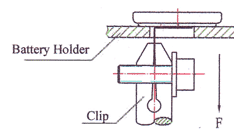

- For batteries with diameter
 20mm (except CR2016), pull weight should be
20mm (except CR2016), pull weight should be  5 kg;
5 kg; - For thin type batteries (e.g. CR1216, CR1220, CR1616 and CR2016), pull weight be
 3kg;
3kg; - For all other models, pull weight be
 4 kg.
4 kg.
- Technical Briefing
- Memory Backup Design Precautions
- General Design Precautions
- Assembly Precautions
The reason mainly lies in that the lithium metal, acting as the cathode active substance, has the highest capacitance (3.86 Ah / g) and high electrode potential among all available cathode metals, performance being quite stable under sealed humid storage and an excellent and long service life.
Q-Lite lithium battery features:
- High voltage and high energy density
The lithium battery features a voltage of more than 3V, twice of conventional batteries, and the lithium metal, acting as the cathode active substance, has the highest capacitance (3.86 Ah / g), thus saving power space and reducing weight for designed product. - Excellent leakage protection capability
Reliable sealing structure, high quality electrolyte and anode & cathode active substances which makes a super sealing-up capability in battery. - Superior temperature behavior
Adopting the reliable conductible organic electrolyte liquor ensures the battery an excellent performance of working between -20oC~+60oC temperature range. The battery, specially formulated and processed, is also applicable for -40oC~+80oC requirement. - Battery minimized self-discharge
For the battery, 2% or less annual self-discharge can be expected. - Superb pulse load characteristics
High rate discharge batteries are available from Q-Lite manufacture. Please see to High Rate Type.
Safety and Handling Precautions
Lithium batteries are safety-related products. Please read the following precautions carefully and follow the instructions strictly:
- Battery contains flammable materials as organic solvent. Misuse of battery may cause leakage, heating, inflammation and even explosion.
- Never charge the battery. Forced charging will result in explosion.
- Keep battery from child. See the doctor immediately if battery swallowed by child.
- If battery electrolyte sputters to eyes or mouth, be sure to use water wash immediately; or contact the doctor if seriously sputtered.
- Don't heat battery, place it nearby fire, put it into water, or dismantle, which may damage the battery, cause leakage, fire or explosion. The battery with electrolyte leakage or odor emission cannot be placed near to fire, otherwise may cause inflammation.
- Don't connect the positive and negative directly, for it will result in short-circuit.
- Avoid mixing the battery with metals or any other electrically conductive objects, for this may cause short circuit, quick heating or explosion.
- During storage, please keep all individual batteries apart from each other so to avoid short circuit due to positive and negative possibly connected directly.
- Be sure to let the batteries’ positive and negative parts placed correctly in products and strictly follow the product user instructions.
- In use do not mix used and new batteries together, different brands, models of batteries. It will lead to battery performance deterioration quickly.
- Do not let the battery exposed to the sunlight directly, or to any high humidity environment, for it may cause battery performance deterioration quickly
Transport Rules of Lithium-Manganese Battery
According to the regulations of «UN Recommendations on the Transport of Dangerous Good», "Special Provision 188", if lithium batteries avoid the mutual short-circuit among batteries and proper safety protection is conducted for packing during the transport period,
then the lithium batteries with not more than 1.0g lithium/cell will be regarded as safety products.
The Q-Lite lithium-manganese dioxide button type batteries completely comply with the technical requirements of this transport criterion.
- Guideline for battery selection:
The following three basic factors are to be taken into consideration when selecting a battery for some electrical appliances:- a) the working current and cut-off voltage;
- b) the service life expected of battery;
- c) the ambient working temperature.
The primary lithium-manganese battery is non-rechargeable. When the battery is used as memory backup together with another main power source to form a combined power supply, the main power may charge the lithium-manganese battery. To avoid the battery being charged or over-discharged, it is recommended to set up a diode to fix the direction of current and a resistance for current limitation protection. (The typical diagram for memory backup vide post.)
The memory backup voltage is to be higher than IC memory backup voltage, i.e.:
VB - VF - IF × R > V IC. - Principle of diode selection:
It is recommended to adopt a diode with minimized reverse leakage current and to set up the right designed circuit, so that the diode's reverse leakage current while the battery in service is not to exceed the 2% of battery’s rated capacity.
Taking CR2450 for example, its rated capacity is 600mAh and service life 4 years, thus the diode's maximum reverse leakage capacity is to be:
600mAh × 2% = 12 mAh
and the related maximum reverse leakage current: 12 mAh ÷ service life (h), i.e. 4 years × 365 days × 24 hours = 0.34 µA
In this case, the diode to be selected is to have its reverse leakage current less than 0.34 µA. - How to apply the protective current-limit resistance
It is necessary to set up protective current-limit resistance in circuit, which shall restrict the current of battery charging in case of diode out of service, and risk due to battery being charged by a big current is also to be avoided.
How the protective current-limit resistance value R is to be calculated:
The R value is to be bigger than the calculated result of the formula below:
V (main power voltage)
R -------------------------------------------------------------------
-------------------------------------------------------------------
I (the battery permissible maximum charging current)
For a safe and effective use of battery, please carefully read the following instructions:
- No direct soldering onto battery.
A long-time direct heating on battery may result in damage and distortion to the separator and sealing gasket, causing leakage, fire and even explosion.
In case soldering is needed to connect batteries, please use right specified pins to connect batteries. While batteries with pins are connected, please make sure the battery surface temperature is not to exceed 80oC.
It is recommended to use nickel plated material or stainless steel to be pins for battery. - For the replaceable spring-leaf-elastic contact, it is recommended to keep contact pressure within the limit of 200~1000 gf and to use multi spot contact (normally, two spots),
so to ensure stability and reliability of contact. The contact points shall be right positioned around battery in order to achieve the best balancing and positioning of battery.
Particularly for a portable device with battery, sufficient consideration is to be taken of vibration compact onto battery contact. The battery compartment shall be designed with its dimensions as close as possible to those of battery body, not too loose, furthermore, to select highly elastic contact pressure and high elastic spring leaf with good structure, so to avoid bad contact owing to battery removal after vibration. - Battery with pins is to be used for those electrical appliances with a need for highly reliable battery contact.
- Keep clean the battery pins’ surface, not let wet or covered with sticky objects, otherwise there will be bad contact on pins.
- Before putting battery in service, be sure to check everything normal on pins and if there is any cut or damage with them. The pins once cut or damaged may cause short circuit.
- Don't over-discharge battery to 0 V.
- Lithium manganese dioxide battery still keeps a high level output voltage even if its capacity mostly exhausted, and often does not make any difference with new ones in voltage. In order to avoid mix use of old batteries and new ones, and when it is not so easy to distinguish between them, it is recommended to replace with new batteries absolutely.
- When lithium manganese dioxide battery becomes short circuited even for a short while, its voltage will be declining obviously. However, it features a recovery performance, and to what extent the recovery is depends upon to what extent the battery is short circuited, though. Lithium manganese dioxide battery needs a certain period of time to recover its electrical performance even if a minor short circuit. Therefore, we have to wait enough time in case of short circuit until the battery recovers to normal voltage before we can conduct any test on it.
- It is recommended to use a voltmeter with a more than 1 MOhm resistance in order to obtain an exact measurement of open circuit voltage of battery.
- Even if batteries are the same in size or shape, their performance may differ from each other due to different sizes and grades. Upon replacing batteries, be sure to verify the model and grade of every battery and replace according to the specified model and grade.
- When designing battery into electrical appliances, battery loading and unloading structure shall be designed not reachable to children, so to avoid being possibly swallowed by children.
- For transportation, manufacturers’ transport and carriage instructions shall be obeyed. Always avoid excessive vibration or tough loading or unloading.
- When there are a few batteries to be used in series or in parallel, or in more complicated conditions, please consult Q-Lite engineer or agents.
Unlike other electronic components, the lithium-manganese dioxide button type battery may become short circuited once placed onto the PCB board even if PCB power not switched on. As a result, the battery energy will be exhausted when the PCB switched on.
Short circuit may occur under the following circumstances:
- Overlapped piling up batteries
Indicated by the below diagram (Sketch Map of Battery Exterior Short-Circuit), the positive and negative terminals of lithium-manganese dioxide button type battery are separated only with a slim ring (sealing gasket), so the positive and negative will easily get connected short circuited when the batteries are piled up overlapped in a disorder.
- Batteries to be left in a metal container or metal plate
Batteries may get short circuited through the electrically conductive metal surface, which is similar to overlapped piling up of batteries, depending upon which positions batteries will be left in the metal containers.
- Picking up battery with metal tweezers
The conductive metal tweezers will cause the battery a short circuit while battery being picked up.
- Battery’s positive and negative pins get crossed directly
Some external forces, i.e. being pressed by other objects, will make both the positive and negative pins bend crossed directly, thus causing short circuit.
- Solder Bridges
An improper soldering may cause short circuit through unwanted solder slag left on the PCB. The solder slag will form the "solder bridge". in solder trailing may form.
- Short-circuit through the electric iron
Similar to the "solder bridge", the electric iron may cause short circuit by connecting positive and negative terminals. The longer the soldering time is, the more energy will be exhausted out of battery.
A soldering operation by hand is recommended to be done within five seconds.
- Piled up placement of PCB
Short circuit may be caused owing to some conductive materials contacted (i.e. extruding solder spots) when the PCB’s are placed piled up.
- Short-circuit via electrically conductive anti-static pad
The electrically conductive pad is usually used to prevent the semiconductor component from being damaged by conductivity. When a PCB already with battery installed inside is placed onto the electrically conductive pad, the soldering spot on the conductive body will cause discharge circuit by contacting the pad.
- Incorrect installation of battery polarities
When a battery is installed with reverse polarities into the battery container, the battery may be discharged depending upon the electrical current direction in the circuit.
- Soldering short-circuit
When the battery pins (both positive and negative) are immerged into the soldering liquid for processing (as for tin processing), the battery will be short-circuited immediately discharged. It is requested that such a processing be done in 5 seconds, the quicker the better.
